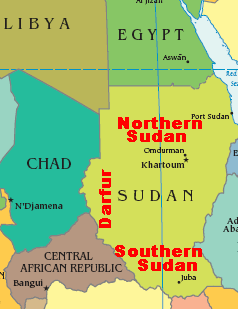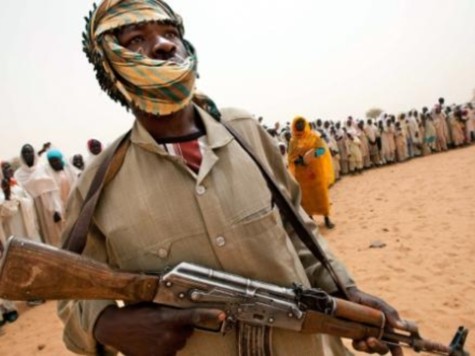
This morning’s key headlines from GenerationalDynamics.com
- Darfur war may explode again soon into full-scale genocide
- History of the Darfur war
- Assad escalates Syria war again with Scud missiles
Darfur war may explode again soon into full-scale genocide

Darfur refugee camp
Violent protests by hundreds of students in Khartoum, the capital ofSudan, were broken up by police using heavy teargas on Wednesday. Theincreasingly potent protests, four days so far, were protesting themysterious deaths of four deaths on December 7 of four Darfuristudents, and the disappearance of two others. The bodies of the deadstudents were found in a canal after they went missing following theirparticipation staged by students from Darfur to protest theuniversity’s tuition increases, in violation of their own signedagreements.
This comes at a time when money and troops are being withdrawn fromthe U.N.’s Darfur peacekeeping force, while violence against themillions of Darfuris in refugee camps is increasing. The U.S. labeledthis a genocidal war in 2004 and the U.N. expended enormous resourcesto separate the sides and stop the fighting.
The war in Darfur, which is a western region of Sudan, has been aninteresting case study for Generational Dynamics, since I’ve been ableto follow it since it turned into a generational Crisis war in 2003.(The other war in that category was the Sri Lanka war, which became acrisis war in 2006, and reached a climax when the Tamil Tigerssurrendered in May, 2009. Sri Lanka is currently in a generationalRecovery era.)
The war began in the 1970s, but the world only discoveredit in 2004, and then it became the most popular war in the world, withfamous movie stars visiting, one after the other.
History of the Darfur war
Low level violence began in the 1970s between two ethnic groups, oneof farmers and the other of camel herders. (There was a similarconflict between farmers and cowboys in the United States in the1800s.) Farmers are infuriated when herds of animals trample theircrops. They’d respond by building fences, and that infuriates theherders. (A more detailed history can be found in my 2007 article, “Ban Ki Moon blames Darfur genocide on global warming”)

Sudan and neighboring countries. Southern Sudan is now a separate country, South Sudan
Prior to 1983, disagreements could be resolved by the elders,but things changed because of the drought and famine that ran from 1983-85.Both farmers and herders were forced to travel to regions with water,and that brought the two sides into closer contact. It also lessenedthe role of local leaders, with the result that both farmers andherders began to turn to Khartoum for help.
In Darfur in 1987, there were outside agitators on both sides,resulting in a brief war.
The two groups of Darfuris — herders and farmers — could also bedistinguished ethnically as Arabs and non-Arabs, respectively. Butthat distinction had never before made as much difference as theindividual tribal identifications, according to Sudan expert Alex de Wall.
A brief 1987 Darfur war was instigated by Libyan leader MuammarGaddafi, who for years had been trying to start up a “pan-Arab”movement across northern Africa, under his leadership. Hedistinguished between the two groups of Darfuris — herders andfarmers — could also be distinguished ethnically as Arabs andnon-Arabs, respectively. He recruited the “Arab” herders, and triedto agitate them to be part of his attack force on the neighboringcountry Chad. That attempt failed, but the identity group name “Arab”stuck, and later became associated with the élite group running thegovernment in Khartoum, who also think of themselves as “Arabs,” andthe other Darfuris as “non-Arabs,” or just “Africans.”
Once that happened, the conflict became international, with outsiderstaking the side of the “Arab” herders or the “African” farmers, dependingon their ideology.
In the 1990s, the level of low-level violence increased in Darfurbetween the two groups. If you’re standing in Khartoum, Darfur isalmost 1,000 miles away, and seems as far away as the moon, and theDarfuris might as well be an alien species. All the Sudangovernment wanted was for the Darfuris to take care of themselves,and leave Khartoum alone. Khartoum was already fully engaged inanother war, with other ethnic groups in what is now South Sudan.
In the 1990s, the Khartoum government essentially delegated theresponsibility of policing the region to the Arab Janjaweed militia,formed from certain groups of herders. This was an ideal solution toKhartoum, since it meant that the “African” and “Arab” Darfuriswould have to solve problems themselves, and Khartoum would stay outof it. This would leave the Sudanese army free to focus on thesouthern war.
The transition from low-level violence to a full-fledged generationalcrisis war occurred in 2002-03. There were two shock events thattriggered this transition.
The first occurred in April, 2002. The young men of one (“African”)farmer village in central Darfur complained to the districtauthorities that they were being harassed by a herder (“Arab”) militiagroup. The shock that they and the farmers received was that, insteadof getting help, the young men were jailed, and so was a lawyer whotried to represent them. This infuriated and radicalized the Darfuri
Jailing the young men was a catalyst the led to the formationof the Darfur Liberation Front.
The second shock event (the “regeneracy”) occurred on February 26,2003. The Darfur Liberation Front attacked a police station to takeback their lost weapons from the time of the arrest. This actionradicalized the “Arab” herders, especially the Janjaweed militia,who previously were supposed to be an impartial police force.
This led to panic in Khartoum. Suddenly the Darfuris, though still1,000 miles away, turned overnight into a huge mass of millions ofpeople ready to attack Khartoum itself!
In the mass hysteria that followed, the conflict escalated into afull-scale genocidal war. The Janjaweed militias (herders) begana program of mass murders, rapes, genocide and scorched earth.
It was only in 2004 that the word “discovered” Darfur. Jesse Jackson,the so-called anti-war activist, wanted President Bush to send troopsinto Darfur to stop the slaughter. Joe Biden wanted to move troopsout of Iraq, where there no civil war, into Darfur, where there wascivil war. He wanted to stop the Darfur civil war with just 2,500American troops, to “end the carnage” and “stop the bleeding.” ( “Still tilting at windmills, the UN will send ‘peacekeepers’ to Darfur”)
The United Nations put millions of Darfuris into tents in the middleof the desert, and dozens of aid organizations sent food in. The ideawas to spend $2 billion a year to “stop the bleeding,” and then sendKofi Annan in to negotiate a peace deal that would end the war andbring peace to the region.
A generational crisis war MUST run its course. If you can imagineKofi Annan’s grandfather trying to negotiate a peace deal in 1944between Britain and Germany, or between Japan and the United States,then you can imagine how ridiculous it was to expect a peace dealbetween the Sudan “Arabs” and “Africans.”
Earlier, I mentioned the Sri Lanka civil war. That war ran its courseand reached a crisis era climax in 2009, which I described in detailwhile it was occurring, as well as before and after.
But the Darfur civil war has NOT run its course, and has NOT reached aclimax. You still have millions of Darfuris out in the middle of thedesert, being protected by a dwindling number of U.N. peacekeepers.Once the peacekeepers are gone, the massive program of genocide,rapes, mass murders and scorched earth will begin again, and this timethe war will reach a climax. Sudan Tribuneand Reuters
Assad escalates Syria war again with Scud missiles
The regime of Syria’s president Bashar al-Assad is escalating the warfurther by firing Scud missiles within Syria, presumably at rebelgroups, according to U.S. officials. The missiles were fired from theDamascus area into northern Syria. They did not cross the border intoTurkey, but they came close. Analysts say the Assad governmentmaintains up to 400 of the short- and medium-range Russian-developedScud missiles. CNN
KEYS:
Permanent web link to this article
Receive daily World View columns by e-mail

COMMENTS
Please let us know if you're having issues with commenting.